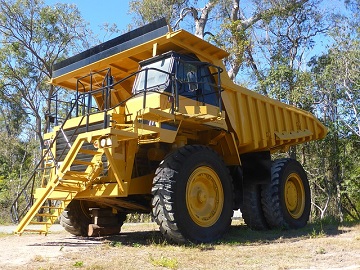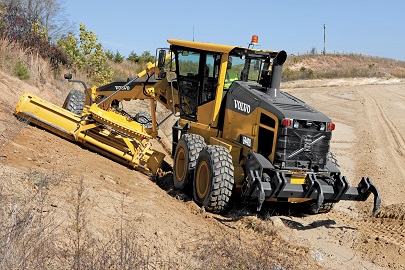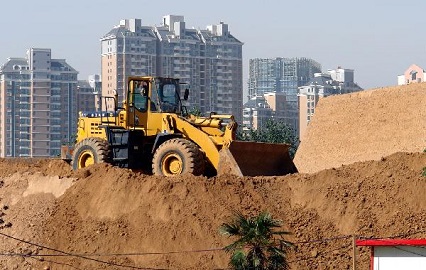Earth-moving plant
Contents |
[edit] Introduction
Earth-moving plant is commonly used on construction sites to transport and place excavated soil. Before beginning earth-moving works, there must be a plan for the amount of material that needs to be moved as well as where it will be moved to.
Generally, the choice of earth-moving plant will depend on:
- The quantity of material to be moved.
- The type and condition of the soil and the site.
- The distance to be moved.
- The speed and turn-around time required.
- The size of the excavating bucket.
[edit] Dumper
Otherwise known as articulated or dump trucks, these are generally the largest of the earth-moving plant types. Capacities can vary from 5 m3 to 30 m3. They are the most suitable option for sites where large amounts of material needs to be transported over distances both on and off site. The vehicles have heavily-plated bodies and are hydraulically operated which allows for quick discharge. There are a wide range of dumpers available with differing carrying capacities and discharge options (front, side or elevated tipping). The most common options are:
[edit] Standard dumper
Diesel powered dumper with gravity tipping skip. Heaped capacity ranges from 0.7-1.5 m3.
[edit] Swivel skip dumper
Hydraulic tipping skip mounted on 180-degree slewing turntable.
[edit] Highway dumper
Much larger dumper used to transport spoil off site. The rear tipping skip is hydraulically operated, and the usual heaped capacity is 10 m3. (see top image)
[edit] Bulldozer
Otherwise known as crawler tractors, bulldozers are track or wheel-mounted with a forward-facing mould blade controlled by hydraulic rams. The blade is capable of tilting about a central swivel point, allowing for a dipping depth of 300 mm. This means they are commonly used for stripping sites, reduced level digging and pushing earth from one point to another.
Bulldozers are also used for clearing vegetation and small trees, acting as a towing tractor and can be adapted as an angledozer which pushes and casts spoil to one side of the mould blade, avoiding side spillage when pushing material forward.
[edit] Scraper
Scrapers are capable of cutting, collecting and moving large quantities of spoil across sites by the use of a scraper bowl for site stripping and leveling operations. One end of the scraper bowl is lowered to collect material whilst the machine is moving. When full the bowl is raised and the machine travels to the discharging are. Scraper capacities vary from 6-50 m3. The main types of scraper are:
[edit] Towed scraper
A four-wheeled scraper unit is towed behind a track-mounted machine. This is a slower option but suitable for medium-sized sites with poor ground conditions.
[edit] Wheel tractor scraper
A tractor unit is mounted on two large rubber-tyred wheels and connected to a two-wheel mounted scraper. The usual carrying capacity is 30-50 m3.
[edit] Elevating scraper
These are smaller machines, with a carrying capacity of around 12 m3, that are quick for working with loose soils.
[edit] Grader
Graders are similar to bulldozers in that they have a long slender mould blade which is used for the bulk movement of earth. Graders can either be four-wheeled or six-wheeled (two at the front, four at the rear).
The adjustable blade is fixed under the centre of the machine and can be raised and lowered in both horizontal and vertical planes through an angle of 300-degrees. A horizontal blade allows for the finishing of earth formations such as roads to a fine limit, whilst a more vertical blade allows for the cutting, shaping and grading of embankments.
[edit] Tractor shovel
Otherwise known as loaders, these machines have a front-mounted shovel bucket (similar to a multi-purpose excavator) which is used to scoop up and raise loose spoil before depositing it into a transport vehicle such as a dumper. They can be either tracked or wheeled, which means that they are suitable for most types of ground condition and commonly have a bucket lifting height of 4.5 m.
Backhoe loaders are fitted with a shovel in the front, and a backhoe at the back. For more information see: Backhoe Loader Market 2015 - 2021.
[edit] Related articles on Designing Buildings
- Back actor.
- Bituminous mixing and laying plant.
- Cherry pickers.
- Compressed air plant.
- Concreting plant.
- Construction plant.
- Construction tools.
- Crane supports.
- Equipment in buildings.
- Excavating plant.
- Forklift truck.
- Health and Safety.
- Hoist.
- Power float.
- Scaffolding.
- Trenching equipment.
- Types of crane.
- Types of roller.
[edit] External references
- ‘Introduction to Civil Engineering Construction’ (3rd ed.), HOLMES, R., The College of Estate Management, (1995)
- ‘Building Construction Handbook’ (6th ed.), CHUDLEY, R., GREENO, R., Butterworth-Heinemann, (2007)
Featured articles and news
Infrastructure that connect the physical and digital domains.
Harnessing robotics and AI in challenging environments
The key to nuclear decommissioning and fusion engineering.
BSRIA announces Lisa Ashworth as new CEO
Tasked with furthering BSRIA’s impressive growth ambitions.
Public buildings get half a million energy efficiency boost
£557 million to switch to cleaner heating and save on energy.
CIOB launches pre-election manifesto
Outlining potential future policies for the next government.
Grenfell Tower Inquiry announcement
Phase 2 hearings come to a close and the final report due in September.
Progress from Parts L, F and O: A whitepaper, one year on.
A replicated study to understand the opinion of practitioners.
ECA announces new president 2024
Electrical engineer and business leader Stuart Smith.
A distinct type of countryside that should be celebrated.
Should Part O be extended to existing buildings?
EAC brands heatwave adaptation a missed opportunity.
Definition of Statutory in workplace and facilities management
Established by IWFM, BESA, CIBSE and BSRIA.
Tackling the transition from traditional heating systems
59% lack the necessary information and confidence to switch.
The general election and the construction industry
As PM, Rishi Sunak announces July 4 date for an election.
Eco apprenticeships continue help grow green workforce
A year after being recognised at the King's coronation.
Permitted development rights for agricultural buildings
The changes coming into effect as of May 21, 2024.



























